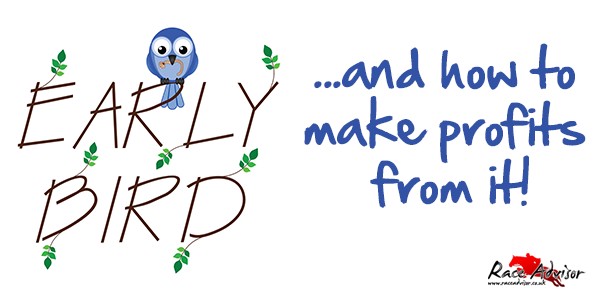Early Birds And First Shows Strategy

As I’m sure you’re aware a bookmaker makes his profit by adjusting odds and making sure that the whole book is covered by an over-round. This over-round secures his long term profit. In today’s article I’ll explain how this works, and show you a trick you can use that will allow you to secure small margins in your favour.
Let’s start by looking at an example of a bookmakers over-round and how it works.
In a two horse race where both horses have the same chance of winning the race, they would share the probability of winning that race of 0.50 or 50%. This equates into even money in terms of odds. That is the true “book” on the race. Of course, this is no good for the bookie as they need to make a profit. In order to do this they add a percentage to each runner so that the whole book is weighted in their favour. They’ll make each horses chance of winning at around 54%, instead of 50%, so that in odds they will become 4/5 shots. This means that they now have a book that stands at 108%.
Broken down this means that were they to take 100 bets at £1 each, and half of those bets were on one horse and the rest on the other. Then whichever horse wins, they’ll only pay back £91.67. Which means that they have secured just over 8% on turnover!
The question is, how can we turn this advantage the bookmaker has into our favour?
And the answer is…
…by playing the market in the same way he does!
As each day progresses, money comes in from punters for various horses and this makes the market move. As the market moves we need to move with it and put ourselves into a better position.
It can take a bit of practice to get this right, but it is worth persevering.
One method of doing this is to look at favourites, but first we need to understand the difference between bookmakers prices and the first show. It’s this difference that we can make profit from!
Bookmakers that offer prices on-line start by offering what they call Early Bird Prices.
Let’s take an example of a favourite in a handicap race. If the bookies open up at 7/2, they’re saying that the horse has a 22% chance of winning that race.
The horse has been tipped up in the newspapers and the Racing Post and so, as the bookmaker sees more and more money coming in for the horse, they shorten the odds.
This shortening of the odds causes even more punters to bet on it at the shorter prices and the odds shorten even more. The horse is now a 2/1 chance because, as it’s more popular than when the bookies first opened the market, they’re now saying that the horse has a 33% chance of winning. That’s an 11% increase in it’s chance of winning from when the market first opened!
The bookmaker has to do this because of the amount of bets being placed on this horse they now have a huge liability it.
Then we come to the first show…
Just 10 minutes before the start of the race the prices we see on the internet, or on the telly, are those being offered by the bookies on course. These are called the first show.
As the on course bookies have only just opened for bets on this race, they’ve not suffered the same liabilities as the early bird prices offered online. This means that they need to attract the on course punter to get bets, and to do that they push the odds up. This means that a lot of the time you’ll find that you can get bigger prices on course. It also means that there’s a 5 to 10 minute period where we can start to understand the bookmakers margins and change them into our favour.
In the image below you can see the odds for a horse that was fancied all day, it had been touted in the media as having a “live” chance. In the morning, the Early Bird prices had opened at 5/1.
Throughout the day the horse was backed into odds as short as 5/2.
Interestingly have a look at the First Show. This was 10 minutes before the off at 17:24.
The runner opened at 9/2 and was then subsequently backed in as the on course money came in for the horse. It then eventually went off as the 3/1 favourite.
These differences in prices make it ideal as a trading proposition.
To do this, you need be on your computer during a Saturday. Use OddsChecker to look through the price history of a horse. If you can see that it’s been gambled on throughout the day, then at 10 mins before the off place a back bet at better odds from one of the on course bookies. You can then lay the horse just before the off to secure a guaranteed profit.
It will take a bit of practice, but once you’ve mastered it you’ll be making a few ticks profit multiple times a day.

Things must have changed – During my early years of betting I use to ask for first show but gave up when they were mostly less than SP.The bookmaker informed me that they always knock a few points off in the morning in case they have made an error and some smart punter would take advantage. I now back just before the off on Betfair and mostly the prices drift out.
Funny game